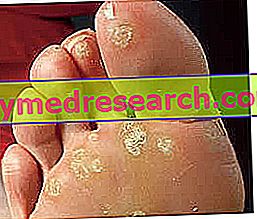Definition
The plantar warts are small skin protuberances, often painful and annoying, which can develop in any area of the sole of the foot or involve only the fingers.

Diagnosis
The diagnosis for plantar warts is quite easy and consists of a simple objective medical examination of the lesion. At the sight, the wart has a structure comparable to that of a miniature cauliflower, with point-like petechiae inside; on the surface we observe particular cutaneous striae that resemble fingerprints. Sometimes, plantar warts are so small that they are confused for a simple callus or corn.
Unlike calluses, however, plantar warts tend to be painful, especially as a result of pressure exerted on them.
In the presence of doubts, the doctor can take a sample of suspect tissue by curettage, for a subsequent cytological (cellular) check in the laboratory.
Treatment
Although plantar warts tend to self-purify within a short period, drug therapy is necessary when the lesions negatively affect the quality of life of the victim. In fact, some plantar warts cause such annoying and expanded sores as to compromise posture and walking. Not to forget, then, the very high percentage of recurrences and the real risk that permanent scars are formed at the points where the warts have arisen. To reduce these possibilities, the advice is to contact a specialized center as soon as possible to undertake early treatment.
When the plantar warts are small, the doctor can opt for a specific podiatric treatment, which is essentially based on the use of substances such as salicylic acid, trichloroacetic acid, nitric acid and liquid nitrogen. As shown by a study reported in the journal Health technology assessment, after 12 weeks of daily treatment with salicylic acid (a known chemical exfoliating-keratolytic agent), applied in the form of a cream directly on the lesions, 10-15% of patients with warts heal completely .
Otherwise, larger warts or multiple warty lesions require more invasive therapy. In such circumstances, the most appropriate treatment is surgical removal, a simple operation - fast and not very painful - that takes place in the clinic.
The alternatives to classic surgery are:
- Cauterization: the destruction of the plantar wart occurs by burning with caustic substances
- Electro-drying: the wart is removed by superficial drying and subsequent curettage (scraping)
- Laser surgery: painful and rather expensive intervention, suitable for large and difficult to treat warts with other methods
Please note
The most appropriate choice for the treatment of this disorder depends on the area in which the warts have arisen, their depth, the number and extent of the skin area involved.
Prevention
Analyzing scientific statistics, it is easy to discover how people walking without shoes - see for example the indigenous peoples - are (almost) immune from plantar warts. According to this, it seems that walking without shoes constitutes an effective stratagem to prevent the papilloma virus from taking root in the skin of the feet, thus giving rise to warts. Walking barefoot, in fact, the skin of the feet becomes thicker and more resistant, protecting the feet from similar injuries. Conversely, it seems that the moisture of the foot enclosed in the shoe creates the ideal conditions for the replication of papilloma virus at the level of the feet.
Considering that in modern society it is almost impossible to walk constantly in bare feet, the advice is still to take off your shoes and socks after walking in common and damp places such as locker rooms or gyms. Alternatively, you can wear simple flip-flops as long as your feet are not completely dry.
Considering, then, that plantar warts are an extremely contagious phenomenon, it is evident that it is important to take the necessary precautions to avoid contracting (or transmitting) papilloma virus by direct contact. For this purpose, the most important precautionary lines to limit the spread of the infection are:
- Wear flip-flops when using common bathrooms, showers and changing rooms
- Avoid the mixed use of toiletry items such as towels and socks
- Cover the plantar warts with a special adhesive bandage during swimming
- Change socks every day
- Air the shoes after wearing them
- Keep your feet clean and dry
- Do not touch the warts of other people
- Do not scratch the plantar warts to minimize the risk of spreading the infection
- Wash your hands often
- Protect the micro-cuts on the feet with sterile gauze or patches
Today, an effective vaccine for plantar wart prophylaxis has not yet been identified: as we know, in fact, these lesions can be caused by numerous and different Papilloma virus strains (which makes it difficult to isolate an effective vaccine for the prevention of plantar warts) .
Curiosity
The vaccines used for the prevention of papilloma virus (eg Cervarix, active against 16 and 18 HPV strains) are generally administered to prevent both precancerous lesions in the cervix and cervical cancer; Gardasil vaccines (active against HPV strains 6, 11, 16 and 18), Gardasil-9 and Silgard also protect against the development of genital warts (genital warts).
Considering that plantar warts are generally induced by the 1, 2, 4 and 63 strains of the papilloma virus, it is understandable why the vaccines currently marketed against this virus (Cervarix and Gardasil) are not effective in protecting against plantar warts.



